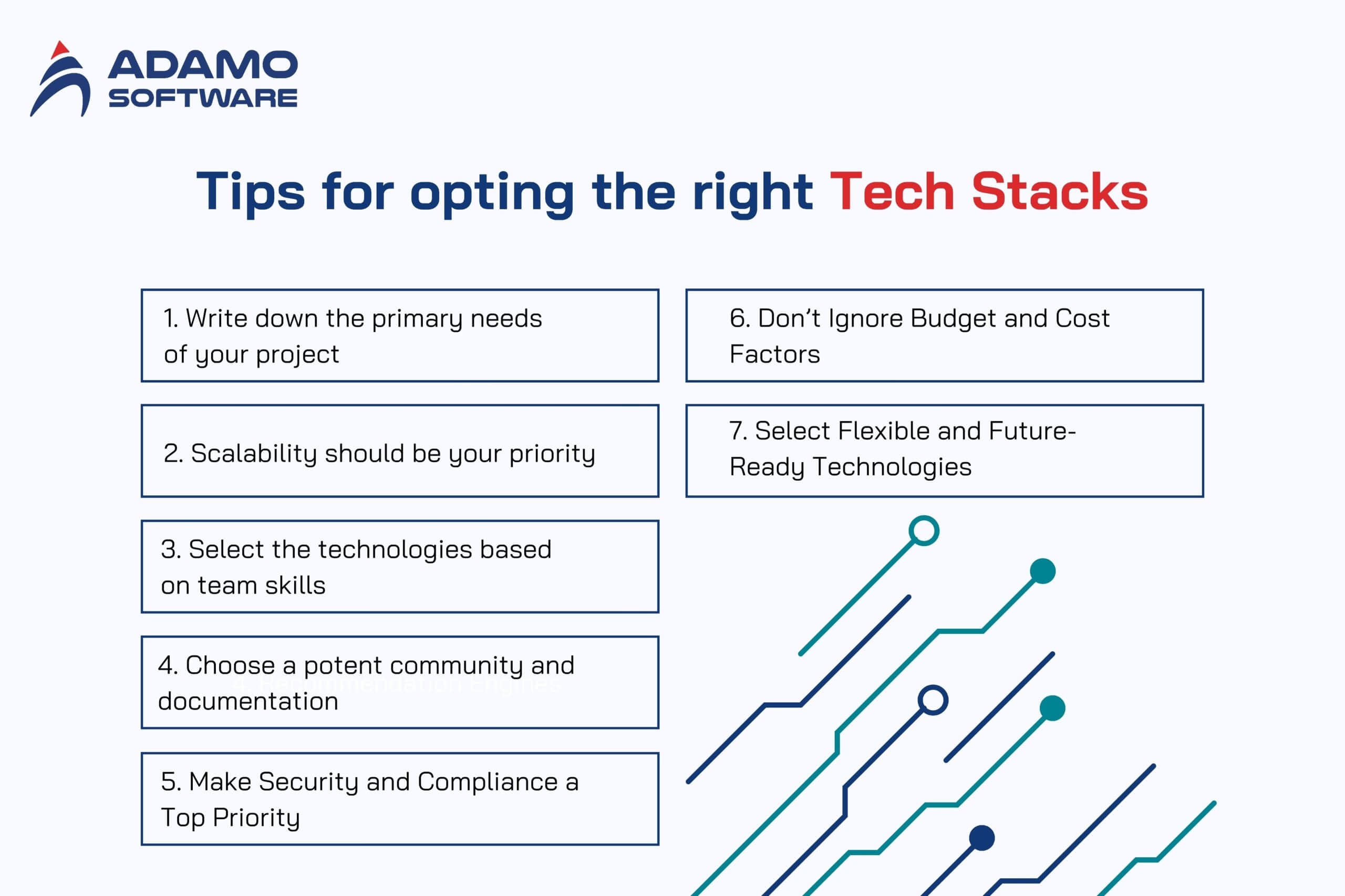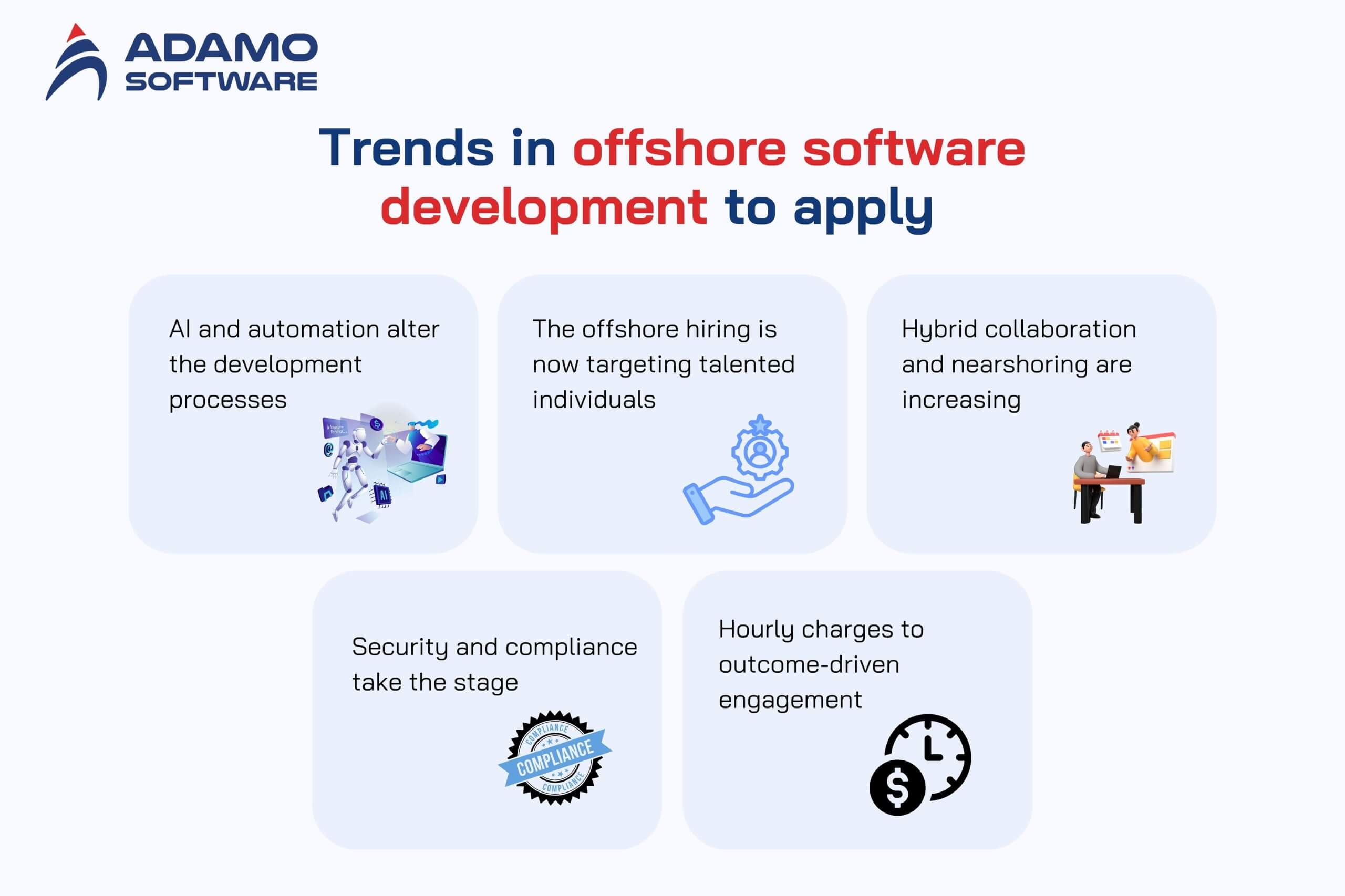Tech stacks for Offshore Software Development: What works best in 2026?

Choosing tech stacks for offshore software development? Discover expert insights and trends that shape modern software projects.
One of the most important decisions in a new software project is the selection of appropriate tech stacks for offshore software development. It is not only about the choice of the tools, but it is also about the long-term success of your team.
The right tech stacks for offshore software development may enhance teamwork, reduce development expenses, and lead to a high-quality product by your offshore team. However, the number of technologies and outsourcing opportunities is too great, so one can easily feel overwhelmed.
In this guide, we will take you through all the information you need to know when making decisions regarding your tech stack.
What we are going to discuss is as follows:
- Tips on stack selection: How to create an appropriate technology stack according to project requirements, team, and development strategy.
- Offshore development stack cost estimation: Regional comparisons to enable you to know the prices and create your budget appropriately.
- The current offshore software development trends: The impact of AI and hybrid teams and new billing systems on the offshoring environment.
- The question of finding the best tech stack: The reason there is no such thing as a one-size-fits-all tech stack is how to create the one that fits you.
So, here is everything, broken down and assisting you in creating a wise, scalable, and affordable tech stack for offshore software development.
I. Tips for opting the right Tech Stacks for Offshore Software Development
The selection of optimal tech stacks for offshore software development is crucial. It will decide the performance of your project, cost-efficiency, and scalability in the long run.
These are some of the things to consider when making decisions:

- Write down the primary needs of your project: Stack them according to the type of app, capabilities, and future vision.
- Scalability should be your priority: Choose the tools that will be able to handle the rise in demand and traffic.
- Select the technologies based on team skills: Choose technologies that your programmers are familiar with.
- Choose a potent community and documentation: Opt for heaps of huge communities and resources.
- Make Security and Compliance a Top Priority: Select stacks that are constructed with data protection in mind.
- Don’t Ignore Budget and Cost Factors: Compare tools based on the cumulative development and maintenance cost.
- Select Flexible and Future-Ready Technologies: Future-proof your product, use modular, adjustable technology.
1. Define Your Project’s Core Requirements
The first step in making the right tool choices is to understand your technical and business needs for the software.
Various types of projects require different tech stacks for offshore software development. The decision should be based on the structure, performance, and security requirements of your app.
Begin with the planning of the key features, workflow of the app, and its development strategy. By doing that, you are not forcing tools to fit; you are picking the tools that do.
2. Scalability should be Your Priority
One of the most essential requirements is that your tech stack should be able to scale in the future. Slowdowns are not an option when the number of users increases.
Choose tech stacks of offshore software development that comply with distributed systems, microservices, and serverless architecture. These alternatives allow you to expand without compromising the stability and speed.
In addition, combine caching, load balancing, and database optimization tools. The features assist in sustaining consistent performance at higher loads.
3. Select the Technologies Based on Team Skills
The technical background of your team is a determining factor in the efficiency of development. When you use the tools with which you are familiar, there are fewer errors and less waiting time.
The tech stacks for offshore software development must be in line with the capabilities of your team. If they are familiar with JavaScript, they can choose React and Node.js frameworks.
Explore Our Tailor-made Software Development Solutions
We are confident in providing end-to-end software development services from fully-functioned prototype to design, MVP development and deployment.
4. Choose Stacks with Potent Community and Documentation
Having an accessible community of developers can go a long way in speeding up learning and problem-solving curves.
Locate tech stacks for offshore software development that have active user communities. Popular technologies will have more tutorials, documentation, and bug fixes.
Access to open-source materials, discussion boards, and GitHub projects will save you dev time and make collaboration much easier.
5. Make Security and Compliance a Top Priority
It is not negotiable to protect sensitive data. Your stack must have security baked in.
When choosing tech stacks for offshore software development, it is essential to pay attention to tools that have built-in security measures and compliance functions. They are supposed to facilitate encryption, secure authentication, and regulations such as GDPR or HIPAA.
In addition, scheduling frequent updates and audits is essential to be secure in the long term.
6. Don’t Ignore Budget and Cost Factors
It does not matter how high-tech it is; it is not worth it when it busts your budget. Make a good choice depending on what you can buy at the moment and in the future.
Tech stacks for offshore software development have to be cost-effective in terms of licensing, hosting, development, and support costs.
It is possible to provide high performance at a low cost with the use of open-source tools, as long as they suit your project. Also, the total cost of ownership should be weighed at all times.
7. Select Flexible and Future-Ready Technologies
Your stack has to change with technology. Inflexible tools may impede the development and flexibility of your product.
Modular, API-driven, and containerizable tech stacks for offshore software development are the smartest ones to use. Such characteristics will enable your product to merge with future tools and platforms.
Be adaptable in case of any changes in the market, user requirements, or any new inventions.
Also read:
Software development strategies: models and methodology
Cost of Software Development: Key factors & Budgeting Advice
II. Cost estimation for the tech stack of Offshore Developers
Although offshoring can already reduce your development costs by up to 50%, there are still areas where you can enjoy more cost-efficiency than others. Not only are the prices low, but it is also what you get in terms of what you pay.
South and Southeast Asia are characterized as having the lowest prices, as well as a great resource of talented developers. These are usually the best places to create cost-efficient tech stacks for offshore software development.
Central and Eastern Europe, on the contrary, are more likely to propose higher hourly rates. But this region also provides high technical competence and profound experience in complex assignments.
Latin America presents a good combination of affordable prices and consistent quality. Besides, this region has a comfortable time zone for North American companies that want to offshore without having to forego teamwork.
Africa, too, is proving to be an upcoming offshoring destination. The region has many countries that are building their tech ecosystems. They provide affordable services and skilled professionals to support tech stacks for offshore software development.
It is also worth knowing about the average development costs in these regions before we look at country-specific comparisons. This helps you assess your savings potential and choose a location that fits your budget and project goals.
An estimation of the offshore software development in each of the various regions in terms of the cost per hour is presented in the table below:
| Junior ($/h) | Middle ($/h) | Senior ($/h) | |
| Central & Eastern Europe | 25-40 | 40-60 | 60-100 |
| Latin America | 25-50 | 50-70 | 70-100 |
| South Asia | 15-30 | 30-50 | 50-80 |
| South East Asia | 10-25 | 25-40 | 40-70 |
| Africa | 15-30 | 30-50 | 50-80 |
III. Trends in offshore software development to apply
The offshore development has gone beyond cost reduction. Innovation, speed, and access to niche skills by means of global collaboration are the things of today.
With the help of the latest trends, you will be able to create more intelligent teams and implement new workflows.
The evolution is being driven by the following:

- AI and automation alter the development processes
- The offshore hiring is now targeting talented individuals
- Hybrid collaboration and nearshoring are increasing
- Security and compliance take the stage
- Hourly charges to outcome-driven engagement
1. AI and automation alter the development processes
The work of development teams is shifting with the help of artificial intelligence. It increases productivity and assists the developers in concentrating on high-impact work.
Contemporary offshore software development tech stacks usually use AI-based tools such as GitHub Copilot to suggest code or automated testing platforms to perform QA. Such solutions minimize the manual effort and speed up the delivery schedules.
Automation of deployment and infrastructure is also valuable for DevOps teams. The resulting impact is shorter turnaround time, fewer bugs, and better releases. Early adopters of AI have a competitive advantage over others in terms of speed and efficiency.
2. The Offshore Hiring is now Targeting Talented Individuals
The days of offshore outsourcing in search of the lowest labor costs are past because the world is full of specialized talent.
The modern companies are interested in partners who are knowledgeable in AI, blockchain, machine learning, and cybersecurity. They are constructing offshore software development tech stacks that have teams with profound domain expertise.
This transformation is altering the company’s location decisions in terms of outsourcing. Technical education and innovation have become a significant selling point in countries with robust technical education systems and flourishing innovation hubs. This means that such countries are now the first preference of clients with complex and high-stakes projects.
3. Hybrid Collaboration and Nearshoring are increasing
The geographical convenience and the improved communication are driving more firms to consider nearshore partners or hybrid team arrangements.
With nearshoring, it is possible to have a closer time zone, cultural compatibility, and collaboration. In the meantime, hybrid models combine onshore personnel with offshore developers, which allows teams to remain agile and reactive.
These solutions facilitate the easier adoption of tech stacks into offshore software development. This is particularly true for cases where the project must be updated regularly and demand real-time feedback.
4. Security and Compliance Take the Stage
In the current regulatory environment, data privacy is a significant issue of concern for companies in all sectors. Vendors offshore are supposed to have high standards of security.
Clients do not only vet partners on their adherence to laws such as GDPR and HIPAA anymore. Those are encryption protocols, access control, and data handling processes.
Another important consideration in the choice of tech stacks to use in offshore software development is security. Teams should have tools that provide secure coding, compliance, and updates. An effective security position fosters trust and long-term relationships.
5. Hourly Charges to Outcome-Driven Engagement
The billing model is changing to one based on impact rather than hours worked. The clients have started to expect the offshore teams to produce measurable outcomes.
Outcome-based contracts integrate the development with business objectives. Deliverables, milestones, and performance are metrics of teams, not coding time.
The trend is altering the way businesses assess offshore vendors and how they can design their tech stacks to support offshore software development. It is concerned with output, value, and long-run outcomes rather than raw labor cost.
IV. What is the top tech stack for offshore software development teams?
By working with your development team, you can choose tech stacks for offshore software development that align with your project goals.
Once you choose the right tech stack, you can increase efficiency and create the foundation of a successful offshore software development process.
However, can any tech stack for offshore software development be considered the best when it comes to working with offshore software development teams? The short reply is no.
The most suitable technology stack is entirely determined by your project’s requirements and your team’s expertise. No universal way out.
Therefore, use the information you have obtained after reading these essential tips and implement it when developing your tech stack.
Ultimately, the selection of the right tools is not only a temporary decision. It is an investment in the future of the software product.
V. Conclusion

The selection of tech stacks for offshore software development is the primary step towards developing scalable, efficient, and cost-effective products. Offshore development success is not a matter of picking the right tool; it is also a matter of choosing the right partner.
In Vietnam, Adamo Software stands out as a leading company specializing in offshore software development. We have worked with clients in various parts of the world in industries such as fintech, healthcare, travel, and logistics.
The level of quality, transparency, and collaboration at Adamo is exceptionally high. We can create tailored technological solutions based on modern tech stacks for offshore software development that align with your business goals.
Seeking an offshore team that you can trust to bring your product into reality? Reach out to us today!











